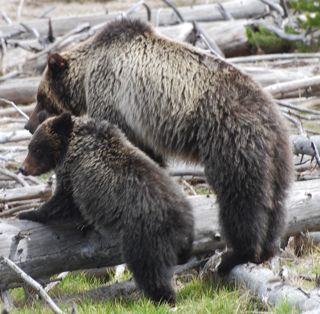 Krummholz Whitebark Pine on Mt. Washburn (NPS Library)The knarled and twisted trunk of the intrepid whitebark pine stands as a testament to the stubbornness of a tree and its will to survive in harsh conditions. Although found at a range of elevations above 7,000 feet, the whitebark gains character the higher it lives, as strong winds and freezing temperatures stunts its growth into a “krummholz” (German for crooked or bent) formation.
Krummholz Whitebark Pine on Mt. Washburn (NPS Library)The knarled and twisted trunk of the intrepid whitebark pine stands as a testament to the stubbornness of a tree and its will to survive in harsh conditions. Although found at a range of elevations above 7,000 feet, the whitebark gains character the higher it lives, as strong winds and freezing temperatures stunts its growth into a “krummholz” (German for crooked or bent) formation.
When I spend time in the subalpine zone, I gaze at the tops of the whitebark pine looking for my favorite bird, the boisterous Clark’s Nutcracker, who plays an important role in the dispersal of the tree’s cones and seeds, and consequently its regeneration. (I have the utmost respect for the Clark’s Nutcracker, who can store over 30,000 seeds in thousands of caches and remember every location!) Watch a video of the bird extracting seeds on the Whitebark Pine Ecosystem Foundation website.
 Whitebark Pine Seeds: A Grizzly Bear's Favorite Food!The nutrient-rich seeds of the whitebark pine support a diverse array of wildlife, from nuthatches and finches, to chipmunks and squirrels. Yet the seeds also provide one of Yellowstone’s largest mammals—the grizzly bear—with a vital component of its diet. Grizzly bears usually don’t pluck cones from the tree, but raid the middens of hardworking squirrels for the majority of their seed consumption.
Whitebark Pine Seeds: A Grizzly Bear's Favorite Food!The nutrient-rich seeds of the whitebark pine support a diverse array of wildlife, from nuthatches and finches, to chipmunks and squirrels. Yet the seeds also provide one of Yellowstone’s largest mammals—the grizzly bear—with a vital component of its diet. Grizzly bears usually don’t pluck cones from the tree, but raid the middens of hardworking squirrels for the majority of their seed consumption.
Although the lodgepole pine is the most common tree in Yellowstone, the whitebark pine may rank as the most important to the park’s ecosystem. The tree acts as a keystone species—a species that exerts significant influence on the ecological community it inhabits, and as a result, its demise can have catastrophic consequences.
 Whitebark Pine in Yellowstone (NPS Library)Unfortunately, those consequences might already be occurring as the whitebark pine is suffering from several ailments—some of which are enhanced by climate change. The mountain pine beetle and the blister rust fungus have begun to gain a foothold, perhaps due to changing climatic conditions. An increase in the frequency of severe fires, also thought by some to be the result of global warming, creates conditions unfavorable for the tree.
Whitebark Pine in Yellowstone (NPS Library)Unfortunately, those consequences might already be occurring as the whitebark pine is suffering from several ailments—some of which are enhanced by climate change. The mountain pine beetle and the blister rust fungus have begun to gain a foothold, perhaps due to changing climatic conditions. An increase in the frequency of severe fires, also thought by some to be the result of global warming, creates conditions unfavorable for the tree.
In early December, the Natural Resources Defense Council petitioned the federal government to list the whitebark pine on the endangered species list. The non-profit group cited some alarming statistics: in portions of the whitebark’s range, 50% of the trees are dead and 80 to 100% of the live trees are infected with blister rust or beetles.
In the press release announcing the petition, NRDC senior wildlife advocate Louisa Wilcox raised the alarm: “If these trees go, they could take Yellowstone’s grizzlies and a lot of America’s western forests with them. If we want to save not just the whitebark pine, but the animals and plants like the grizzly bear that depend on this tree for food, we need to move to protect and restore them now.”
Below is an excellent video by the NRDC on the threatened status of the whitebark pine.
How can you help? Support the important work of organizations like the NRDC and The Whitebark Pine Ecosystem Foundation. For more information on the whitebark pine, you can also visit an overview at the Greater Yellowstone Science Center.
